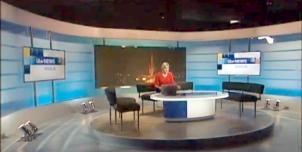Full Freeview on the Sudbury (Suffolk, England) transmitter
| Google Streetview | Google map | Bing map | Google Earth | 52.005,0.786 or 52°0'17"N 0°47'8"E | CO10 5NG |
The symbol shows the location of the Sudbury (Suffolk, England) transmitter which serves 440,000 homes. The bright green areas shown where the signal from this transmitter is strong, dark green areas are poorer signals. Those parts shown in yellow may have interference on the same frequency from other masts.
_______
Digital television services are broadcast on a multiplexes (or Mux) where many stations occupy a single broadcast frequency, as shown below.
64QAM 8K 3/4 27.1Mb/s DVB-T MPEG2
H/V: aerial position (horizontal or vertical)
The Sudbury (Suffolk, England) mast is a public service broadcasting (PSB) transmitter, it does not provide these commercial (COM) channels: .
If you want to watch these channels, your aerial must point to one of the 80 Full service Freeview transmitters. For more information see the will there ever be more services on the Freeview Light transmitters? page.
Which Freeview channels does the Sudbury transmitter broadcast?
If you have any kind of Freeview fault, follow this Freeview reset procedure first.Digital television services are broadcast on a multiplexes (or Mux) where many stations occupy a single broadcast frequency, as shown below.
64QAM 8K 3/4 27.1Mb/s DVB-T MPEG2
H/V: aerial position (horizontal or vertical)
The Sudbury (Suffolk, England) mast is a public service broadcasting (PSB) transmitter, it does not provide these commercial (COM) channels: .
If you want to watch these channels, your aerial must point to one of the 80 Full service Freeview transmitters. For more information see the will there ever be more services on the Freeview Light transmitters? page.
Which BBC and ITV regional news can I watch from the Sudbury transmitter?

BBC Look East (East) 0.8m homes 3.2%
from Norwich NR2 1BH, 77km north-northeast (24°)
to BBC East region - 27 masts.
70% of BBC East (East) and BBC East (West) is shared output

ITV Anglia News 0.8m homes 3.2%
from NORWICH NR1 3JG, 78km north-northeast (24°)
to ITV Anglia (East) region - 26 masts.
All of lunch, weekend and 80% evening news is shared with Anglia (West)
Are there any self-help relays?
| Felixstowe West | Transposer | 1000 homes +1000 or more homes due to expansion of affected area? | |
| Witham | Transposer | 14 km NE Chelmsford. | 118 homes |
How will the Sudbury (Suffolk, England) transmission frequencies change over time?
| 1984-97 | 1997-98 | 1998-2011 | 2011-13 | 1 Aug 2018 | |||||
| B E T | B E T | B E T | E T | K T | |||||
| C29 | SDN | ||||||||
| C31 | ArqA | ||||||||
| C35 | C5waves | C5waves | |||||||
| C37 | ArqB | ||||||||
| C41 | ITVwaves | ITVwaves | ITVwaves | D3+4 | D3+4 | ||||
| C44 | BBC2waves | BBC2waves | BBC2waves | BBCA | BBCA | ||||
| C47 | C4waves | C4waves | C4waves | BBCB | BBCB | ||||
| C51tv_off | BBC1waves | BBC1waves | BBC1waves | ||||||
| C56tv_off | ArqB | ||||||||
| C58tv_off | SDN | ||||||||
| C60tv_off | -ArqA |
tv_off Being removed from Freeview (for 5G use) after November 2020 / June 2022 - more
Table shows multiplexes names see this article;
green background for transmission frequencies
Notes: + and - denote 166kHz offset; aerial group are shown as A B C/D E K W T
waves denotes analogue; digital switchover was 6 Jul 11 and 20 Jul 11.
How do the old analogue and currrent digital signal levels compare?
| Analogue 1-4 | 250kW | |
| SDN, ARQA, ARQB, BBCA, D3+4, BBCB | (-4dB) 100kW | |
| Analogue 5 | (-7dB) 50kW | |
| Mux 2* | (-14.9dB) 8.1kW | |
| Mux B* | (-15.2dB) 7.5kW | |
| Mux 1* | (-15.5dB) 7kW | |
| Mux A* | (-17dB) 5kW | |
| Mux C* | (-22.2dB) 1.5kW | |
| Mux D* | (-23.6dB) 1.1kW |
Which companies have run the Channel 3 services in the Sudbury transmitter area
|
|
Saturday, 25 August 2018
H
Hardy6:31 PM
Nick . Yes . The setting would be different between 8ft and roof top. Actually as youre over 50 miles away from the main transmitters the maximum gain may well be the best setting!
Incidentally in that website of aerial info I mentioned he doesn't think much of the tri beam aerials . Theyre no better than good x beam aerials and catch the wind . Its quite common to see the reflectors blown off!
| link to this comment |
Sunday, 26 August 2018
Hardy, I am on the wrong side of town for Tacolneston, Sudbury comes in well but as described, easily knocked out.
With regard to boosters. Whilst on a good day, 27db is fine, but I have a feeling that on a bad day, ie when I am having problems, lesser amplification means I get knocked out less often. Is this possible?
Do you remember the J Beam aerials with square dipoles and reflectors? I have made one with three booms and it is wonderful. The reflector is small and hollow, so does not fall off. It used to be described as a slot aerial.
As far as I know, tribeams and shallow x aerials BOTH have large reflectors, unnecessarily so in my opinion.
Lately I have seen aerials with directors which look like hollow bottles, two per director placed neck to neck. Do you know these? Are they better?
| link to this comment |
H
Hardy9:11 PM
nick. yes I remember the j-beam square reflector . The x shaped elements give wider bandwidth . The triax or Wolsey modern aerials use rounded elements . The gain seems no different than x beams. I believe the large reflectors are to reduce pick up in the 180 degree direction . (quite useful for you as probably some of you interference is from Dutch and German transmitters ) They must also act as "corner reflectors" presumably to boost performance over part of the frequency range . Its true that too much amplification can be as bad as too little but can't tell if that's your problem. I thought you were aiming for Tacolneston because Sudbury does not have com7 and 8 . Agreed that the coverage checker indicates you get a slightly weaker signal from Tacolneston.
| link to this comment |
Monday, 27 August 2018
thanks Hardy.
I would like to get Tac, but there are houses in the way. I can get a couple of the muxes now and then, but definitely not the weak ones, and only wanted them to get Al Jazeera which gave up its SD mux.
Many years ago J Beam were good enough to answer a few questions, telling me that I must not replace the square hollow reflector with something larger, as the reflector and dipole work on the 'slot' system, receiving a different aspect of the signal from other aerials....magnetic or something.
Why would the x shape give wider bandwidth? Those elements are very short, best suited to the c/d group in my opinion.
My home made is designed for channels 29-47. In essence it has group A dipole and reflector, both ex J Beam hollow, with three lines of group B directors almost parallel about 4 inches apart. Slight modification to balun.
| link to this comment |
H
Hardy9:22 AM
The x is a way of simulating a thick element . Its cheaper and lighter than a true thick element . Thick elements have a wide bandwidth and are shorter than thin elements for a given frequency . You can see true thick element aerials at airports . The j aerial was described as a skeleton slot . I think its more like a stacked quad. Your version of the j is interesting . I think if you like building aerials a "grid" (bill board antenna) is less critical to get right . That's four dipoles in front of a flat screen. It is a medium gain slightly better than a log . I would like to build one with directors tuned for com7/8. In recent times a new version of this a "Hoveman Grey " is popular . seemingly having the same performance but easier to build. Look online.
I will probably stop discussing design here as this site is mainly for answering peoples reception problems. If you would like further discussion I am at dottir@hotmail.com
| link to this comment |
Wednesday, 29 August 2018
Thanks Hardy.
Those shallow x's come in two versions, one being like two V's, the other is 4 separate short elements. I can understand the former being 'thick' but not the latter.
By 'grid' do you mean kooman array, ie full wavelength dipoles? I am not sure this would have enough gain and that is what I need or would have gone for a log.
I am experimenting with five rows of reflectors on my J Beam.
I will let you answer reception problems. There are so many of them since they forced us to go wideband, though Sudbury's channels are now closer than before. I hope they leave them that way and a shame they did not make it like that when they went digital.
| link to this comment |
H
Hardy3:40 PM
yes a Kooman . but nowadays they use large x shapes rather than true fullwave dipoles to get the full UHF bandwidth . I am 30 miles from Tacolneston so am thinking of building one as it covers the full band with a peak near UHF channel 55 56 handy for com 7 and 8.
A large group K is probably the best you can purchase.
Home building in your area I would build or buy a small group A vertical polarised for ALderbrough com 1 2 3 and combine it with a narrower band amplified version of a group B (horizontal) . com 4 5 6
Adding reflectors wont increase the gain . Would it cut down unwanted reverse direction reception any better than a single large grid reflector?
| link to this comment |
Hardy,
would give up on trying to get the weaker channels from Tac, if I were you, specially if on high channels Where are you?
The aerial you describe for me is more or less what I am building. 5 rows of 8 group B directors. Group A square J beam dipole, but while keeping its total length as group A, I have 'squashed' it. It is now a rectangle, vertical, which conveniently makes its width group B. This extra height means I can get 5 rows of directors without them being only a couple of inches apart.
One reflector, about a foot square, netting. Despite J Beam saying it had to be a hollow square slot, like the dipole, that is what I am doing.
| link to this comment |
H
Hardy9:01 PM
Ok. Good luck.usually there would be four rows each row with a dipole all fed in phase and having a bigger reflector. The single rectangle might need adjustable size to tune it .
| link to this comment |
Select more comments
Your comment please




